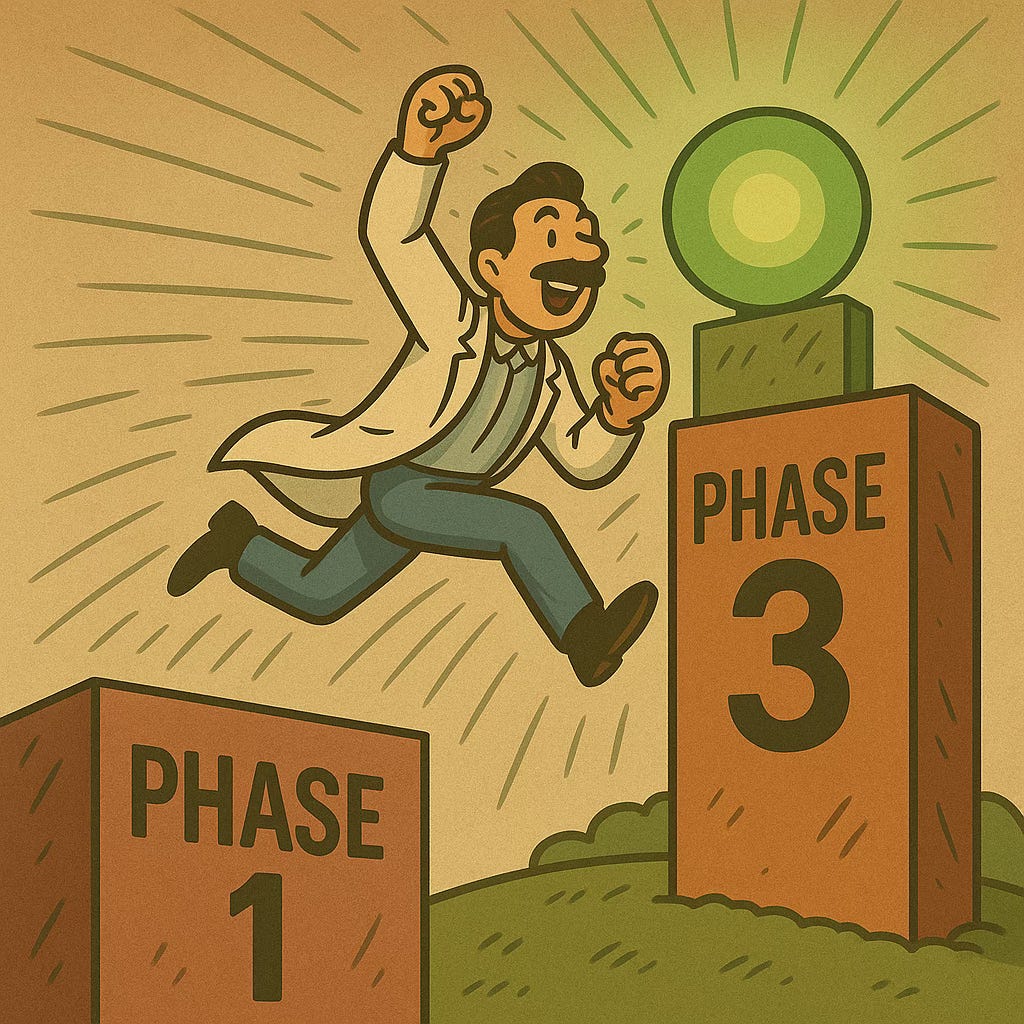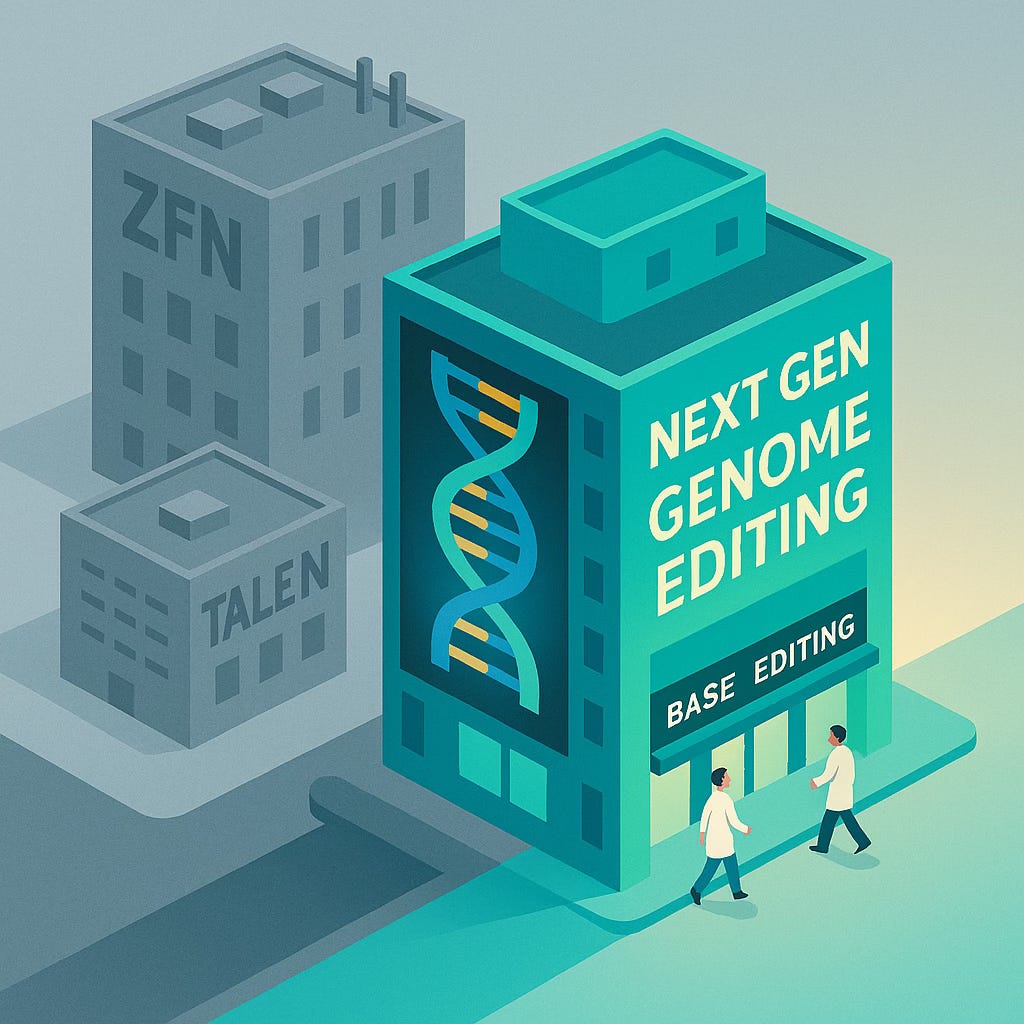The Gene Editing Revolution — Technology, Companies, and Outlook (2025), Part II
CRISPR: A Breakthrough on Par with Antibiotics and DNA — Are We One Step Away from Cures for Cancer and HIV?
Informational and analytical only — not investment advice.
💧
liquidity
Haven’t read the first part yet? You can find it here 📬 In Part I, we explored the fundamentals of CRISPR-Cas9 and the pioneers who first brought this technology to the public markets. Now we’re closing the loop: reviewing the next wave of players, summarizing clinical results from 2023 to 2025, examining the industry’s challenges, and outlining what lies ahead.
The Landscape of Gene Editing and Its Key Players (continued)
In Part I, we explored the fundamentals of CRISPR-Cas9 and the pioneers who first brought this technology to the public markets. Now we’re closing the loop: reviewing the next wave of players, summarizing clinical results from 2023 to 2025, examining the industry’s challenges, and outlining what lies ahead.
Beam Therapeutics — Base Editing: Less Cutting, More Meaning
Beam Therapeutics was founded in 2017 by scientists from MIT and Harvard, including David Liu — the creator of base editing. The company’s mission is to bring base editors into the clinic: tools that rewrite single DNA letters without cutting both strands. These are engineered proteins that combine a “nicked” Cas nuclease (which binds DNA but doesn’t cleave it) with a base-modifying enzyme, such as a deaminase. This enables precise C→T or A→G conversions at targeted genomic sites [8]. By avoiding double-strand breaks, base editing reduces the risk of chromosomal rearrangements and unintended oncogene activation [8]. Beam is developing both cytosine and adenine base editor platforms, adapting them to multiple therapeutic areas.
One of its first programs is BEAM-101, targeting sickle cell disease. Instead of cutting the BCL11A gene like CRISPR Tx or Editas, the base editor introduces a single change in the regulatory region of fetal hemoglobin (HbF). The goal is similar: a durable increase in HbF and resolution of symptoms [8, 64]. In January 2024, Beam dosed its first U.S. patient in an ongoing Phase 1/2 study evaluating safety and preliminary efficacy [8, 64].
Beam is also active in oncology. In 2022, a team from Great Ormond Street Hospital reported a teenage patient with refractory T-cell leukemia treated with base-edited CAR-T cells targeting CD7 — achieving remission and enabling a curative transplant [65–67]. Meanwhile, Beam’s BEAM-201 program develops allogeneic anti-CD7 CAR-T cells with multiple edits, including TCR knockout and modifications preventing rejection and self-targeting [68]. The first patient has already been treated, though the company postponed its data release from late 2024 to 2025 [69].
Beam is further expanding into in vivo therapies. Instead of CRISPR-Cas9, it uses base editors delivered via lipid nanoparticles (LNPs). Projects include editing PCSK9 or ANGPTL3 for dyslipidemia, though Verve Therapeutics has become the clear front-runner in this field. Still, Beam’s broad collaboration with Pfizer — targeting diseases of the liver, muscle, and central nervous system — represents major potential, particularly for DMD and selected CNS disorders. The alliance also extends to extra-hepatic delivery, a key technical frontier.
Strengths. Base editing is “CRISPR 2.0.” The ability to correct point mutations without breaking DNA reduces structural off-targets and broadens therapeutic scope. In genes where cutting would be risky, a single-letter edit can be enough. Beam holds foundational patents from Liu’s lab, licenses its technology, and maintains a diversified pipeline spanning hematology, oncology, and cardiometabolic diseases, bolstered by strong partnerships (notably Pfizer). Financially, the company secured substantial funding during the biotech boom; its roughly $2 billion valuation in 2025 reflects investor confidence in its platform [42, 43].
Weaknesses. Clinical data remain early. Base editors can still cause unintended changes within the “editing window” or lead to mosaicism. Their range of conversions is limited (e.g., only C→T or A→G), meaning some mutations can’t be fixed this way; in such cases, prime editing may be superior. The next 1–2 years will be pivotal, as first patient data emerge.
Be up to date with technology. The stories worth translation 🏖️
Caribou – universal CAR-T
Caribou Biosciences, based in Berkeley and co-founded by Jennifer Doudna, began as a tool-focused company before evolving into a therapeutic player. Its hallmark innovation lies in chimeric guide RNAs (chRDNA) — hybrid guides designed to enhance precision and reduce off-target effects. Caribou has built its identity around allogeneic CAR-T therapies for hematologic malignancies.
The company’s lead program, CB-010, consists of anti-CD19 CAR-T cells engineered with two critical edits: TRAC knockout, which minimizes graft-versus-host reactions, and PD-1 disruption, which helps the cells resist tumor-induced exhaustion [70]. In a Phase 1 trial, 15 of 16 patients responded, with 7 achieving complete remissions lasting over six months [70, 71]. Remarkably, one patient maintained remission for more than 24 months. Competing programs such as ALLO-501/501A from Allogene have reported remissions exceeding 31 months [72, 110].
The FDA granted CB-010 RMAT, Fast Track, and Orphan Drug designations, streamlining its regulatory path [73, 74]. Caribou plans to initiate a Phase 3 trial in the second half of 2025, following the finalization of the protocol and the presentation of extended Phase 1 data [112].

The CB-011 program (anti-BCMA for multiple myeloma) is currently in Phase 1; dose-escalation enrollment has been completed, and full data from >25 patients along with RP2D selection are expected in the second half of 2025 [112]. CB-012 (anti-CLL-1 for AML) previously held Fast Track and Orphan Drug designations, but in April 2025, the program was discontinued, with resources redirected toward CB-010 and CB-011 [113]. These decisions coincided with restructuring and a ~32% workforce reduction. The company reports a cash runway through the second half of 2027[115], which, while providing financial stability, increases the concentration of risk on its two lead programs.
Strengths. Caribou has reported some of the most compelling data to date among allogeneic CAR-T therapies. In the ASCO 2024 analysis, patients with ≥4 matched HLA alleles achieved a median PFS of 14.4 months, compared to 2.8 months for those with ≤3 matches [32, 78, 114]. The safety profile is notably favorable for the CAR-T class — no GvHD signals and low incidence of severe neurotoxicity. However, competition continues to set a high bar for durability of response [110]. The company also benefits from a strong IP portfolio and a strategically focused pipeline.
Weaknesses. Manufacturing scalability and cost remain major hurdles across the cell therapy field. The allogeneic CAR-T space is crowded, with Allogene, NK-based platforms, and TCR therapies all advancing in parallel. The decision to exit non-oncology programs and pause in vivo efforts in 2025 simplifies focus but heightens vulnerability to the outcomes of just two key assets. The long-term safety of gene-edited immunotherapies remains a critical unknown.
The rest of the field: from “holy grail” to “lipid reset”
Prime Medicine — founded in 2021 — is advancing prime editing, a technology where Cas9 nicks only one DNA strand, while a reverse transcriptase inserts, deletes, or replaces precise sequences [9]. This approach opens the door to correcting mutations beyond the reach of traditional CRISPR or base editing. In 2025, the first translational proof-of-concept was reported in a patient with a rare immunological disorder — a milestone event, albeit a single case [9, 10]. The company remains preclinical, yet its ~$1 billion valuation in 2025 reflects sustained market confidence in the long-term promise of prime editing [43].

Verve Therapeutics. Verve’s ambition is to prevent cardiovascular disease through one-time gene editing of lipid-regulating genes. Its lead candidate, VERVE-101, silences PCSK9 in the liver using lipid nanoparticles (LNPs) and a base editor. In first-in-human trials conducted in New Zealand and the UK, LDL levels fell by 40–55%, with the effect lasting at least six months [81], alongside an almost complete elimination of circulating PCSK9 protein [83]. However, serious adverse events in high-risk patients prompted FDA caution; after additional data review, the agency lifted its clinical hold in October 2023 [84–86]. The company plans to advance into Phase 2 during 2025. Its second program, VERVE-201, targets ANGPTL3. In the long run, these candidates could be used preventively in broader populations — provided safety is unequivocally demonstrated [87–92]. Notably, CRISPR Therapeutics is running parallel programs targeting PCSK9 and Lp(a) [89, 90].
Cellectis. A pioneer of TALEN technology and one of the architects of early CAR-T therapies in Europe. Today, it co-develops allogeneic CAR-T programs with Allogene Therapeutics for lymphoma and multiple myeloma. In 2021, the FDA temporarily halted its trials after detecting chromosomal abnormalities later deemed benign clonal events. While TALEN editing is highly precise, it remains less flexible and operationally demanding compared to CRISPR or base editing.
Sangamo Therapeutics. A pioneer of zinc finger nucleases (ZFN). In 2017, Sangamo became the first company to deliver an in vivo gene-editing therapy — for MPS II — though the trial failed to produce a clinically meaningful enzyme increase. The company also explored CCR5 editing in T-cells for HIV. Today, Sangamo focuses on CAR-Tregsfor autoimmune disorders and epigenetic editing. Despite once holding numerous pharma collaborations, several were later discontinued. The company continues to operate, but its influence has waned in the CRISPR era.

Note on Partnerships
The gene-editing industry runs on partnerships with Big Pharma. Vertex backs CRISPR Therapeutics, Regeneronsupports Intellia, and Pfizer has teamed up with Beam (having previously partnered with Sangamo). Novartis invested early in several startups, while Bristol Myers Squibb (BMS) collaborated with Editas. Eli Lilly has partnered with both Precision BioSciences and Verve Therapeutics, signaling an interest in expanding into cardiometabolic targets. Meanwhile, institutional investors such as ARK Invest and BlackRock have built significant exposure to the space.
These alliances provide capital, know-how, and access to manufacturing infrastructure, but they also come with trade-offs — reduced autonomy, rights of first refusal, and commercial dependencies that can narrow strategic flexibility.
As scientific risk declines, the spotlight shifts to execution quality and corporate governance. Inefficient management can undervalue a company relative to its scientific merit, or even erode liquidity, leaving it in a weakened negotiating position — a setup that often precedes unfavorable takeovers.

One could also say that Big Pharma’s investments in gene editing strengthen the credibility of the entire field — when the giants start betting real money, it’s no longer just a scientific dream but a sector maturing toward industrial scale.
Conclusion — Part II
In Part I, we saw how Editas, Intellia, and CRISPR Therapeutics opened the era of CRISPR commercialization. By now, one thing is clear: CRISPR is no longer a promise — it’s a bill — clinically payable, but still commercially negotiated. The next 24 months will determine who truly has the technology, and who merely has a presentation. Some will learn the gravity of capital, others — the scale of manufacturing and the patience of regulators.
With that, we conclude the mapping of the second wave of players. Part III (final) will no longer ask who holds the technology, but rather where the field stands clinically in 2023–2025, what approval milestones lie ahead, and what scaling, cost, and regulatory barriers remain. We’ll also ask the key question: who can realistically turn CRISPR from a promise into a fully-fledged market for precision medicine.
To be continued… and with it comes ✨
🧬 The Gene Editing Revolution — Part III (Final)
🦄💎 The Opening of the Unicorn Vault
“He peeked inside — and felt the magic of rarity, the magic of discovery.”
🦄💎 Unicorn Vault
🧬
🧧
This material is provided for educational and informational purposes only. It does not constitute investment advice or an offer within the meaning of applicable law. The author bears no responsibility for investment decisions made on the basis of this content.
📚 Selected References
· U.S. Food and Drug Administration – press release on the approval of the first CRISPR therapy (Casgevy) for sickle cell disease [2][3].
· Innovative Genomics Institute, CRISPR Clinical Trials: A 2024 Update – overview of ongoing CRISPR trials, including results in SCD/TDT, ATTR, HAE, and CAR-T [111][48][53][70].
· STAT News, Jason Mast, The CRISPR companies are not OK (2025) – analysis of the sector’s challenges and the gap between scientific breakthroughs and financial success [1][40].
· Nanalyze, When Will Gene Editing Stocks Finally Take Off? (2025) – examination of correlations and valuations across gene-editing companies [109][43].
· Nature News, Heidi Ledford, World first: ultra-powerful CRISPR treatment trialled in a person (2025) – coverage of the first use of prime editing in a human patient [9][10].
· The Guardian, Ian Sample, Chinese scientist who edited babies’ genes jailed for three years(2019) – report on He Jiankui’s case and its ethical fallout [11][12].
· Fierce Biotech, James Waldron, Graphite’s hopes for sickle cell ‘cure’ blunted after first patient dosed experiences serious event (2023) – report on Graphite Bio’s halted trial [103].
· U.S. FDA – background on indications and mechanism of action for Casgevy and the parallel lentiviral therapy (Lyfgenia) [2][3].
(Sources: high-reputation English-language publications with up-to-date scientific and financial data as of August 2025.)
📖 References
[1] [40] [59] The CRISPR gene editing revolution loses its mojo. STAT News. (Feb 2025). Link
[2] [3] [4] [5] [18] [116] FDA Approves First Gene Therapies to Treat Patients with Sickle Cell Disease. FDA Press Release. (Dec 2023). Link
[6] [7] CRISPR Illustration. National Institute of General Medical Sciences. Link
[8] [13]–[15], [19]–[21], [22]–[39], [41], [44]–[49], [50]–[58], [61]–[63], [64]–[111] CRISPR Clinical Trials: A 2024 Update. Innovative Genomics Institute. (2024). Link
[9] [10] Ledford H. World first: ultra-powerful CRISPR treatment trialled in a person. Nature. (2025). Link
[11] [12] Sample I. Chinese scientist who edited babies’ genes jailed for three years. The Guardian. (Dec 2019). Link
[42] [43] [79] [109] When Will Gene Editing Stocks Finally Take Off? Nanalyze. (Jul 2025). Link
[60] Editas, changing course again, looks to partner lead CRISPR therapy. BioPharma Dive. (2024). Link
[103]–[106] Waldron J. Graphite’s hopes for sickle cell ‘cure’ blunted after first patient dosed experiences serious event.Fierce Biotech. (2023). Link
[110] Allogene Therapeutics Presents Updated ALLO-501/501A Phase 1 Data. ASCO Annual Meeting. (2024). Link
[111] Exploring FDG PET + MRI for multiple myeloma staging. J Clin Oncol. ASCO (2024). Link
[112] [113] [115] Caribou Biosciences Reports Q2 2025 Results and Pipeline Update. Caribou Investor Relations. (Aug 2025). Link
[114] CB-010 (ANTLER trial) clinical update. J Clin Oncol. ASCO (2024). Link
[117] Prime Medicine announces breakthrough clinical data (PM359, CGD). Prime Medicine Investor Relations. (2025). Link




